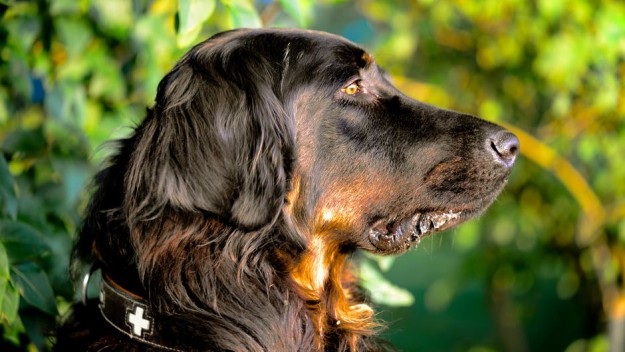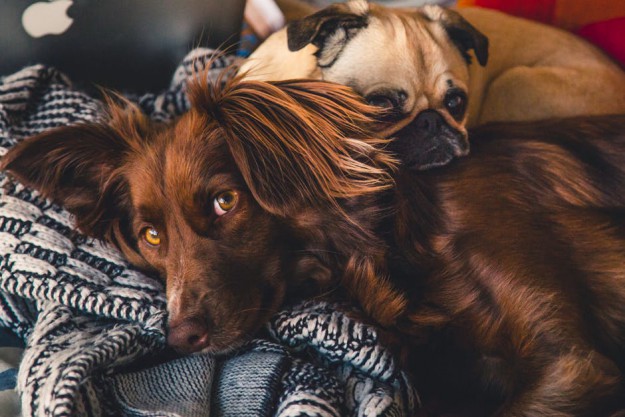
Gordon Setter
USD $800-$1000 Price Avg.
Gun Dog
Group
Purebred
Breed Type
Large
Size
10-12 years
Lifespan
Breed Information
| Group | Gun Dog |
|---|---|
| Popularity/Rank | 104 |
| Origin | Scotland |
| Other Names | Gordon Castle Setters |
| Breed Type | Purebred |
| Price (Avg.) |
USD $800-$1000
How much does it cost to buy a Gordon Setter? Gordon Setter are usually priced differently from breeder to breeder and from place to place. As a rough guide, you can expect to pay between $800 to $1000 if you purchase your dog from a reputable breeder. The price will increase if the dog has a fantastic pedigree. Dogs that already have basic training maybe even more expensive. But, most Gordon Setters can be adopted through a shelter for a lower fee. |
| Size | Large |
| Weight |
Male: 55-80 pounds (25-36 kg),
Female: 45-70 pounds (20-32 kg) |
| Height |
Male: 24-27 inches (61-69 cm),
Female: 23-26 inches (58-66 cm) |
| Lifespan | 10-12 years |
| Recognized by |
AKC, FCI
The American Kennel Club in 1878 as a Sporting breed. And FCI in the Pointing Dogs group, in the British and Irish Pointers and Setters section. |
| Purpose | Hunting, Retrieving |
| Date of Origin | 1600s |
| Ancestry | Setting Spaniel |
Appearance & Maintenance
| Coat | Shiny, Soft, Straight, Wavy |
|---|---|
| Coat Colors | Black, Red, Tan |
| Grooming Level | |
| Shedding Level | |
| Eye Color Possibilities | Brown |
| Nose Color Possibilities | Black |
| Coat Color Possibilities | Black, Brown, Fawn |
| Coat Length | Large |
| Coat Density | Dense |
| Coat Texture | Wavy |
| Recommended Brushes | Comb, Dematter, Nail Clipper, Pin Brush |
| Brushing Frequency | Daily |
Breed Characteristics
| Temperament | Alert, Confident, Eager, Fearless, Intelligent, Loyal, Vigilant |
|---|---|
| Intelligent | |
| Trainability | |
| Playfulness | |
| Sensitivity Level | |
| Affection Level | |
| Social Interaction Required | |
| Barking | |
| Watchdog Ability | |
| Territorial | |
| Biting Force | Low |
| Mouthiness | |
| Impulse to Wander or Roam | |
| Prey Drive | |
| Adaptability | |
| Tolerates Being Left Alone | |
| Fighting Dog | Not really |
Good & Friendly with
| Apartment Life Friendly | |
|---|---|
| Stranger Friendly | |
| Kid-Friendly | |
| Cat Friendly | |
| Dog Friendly | |
| Office Friendly | No |
| Senior Citizens Friendly | |
| Pet Friendly | |
| Friendly with First Time Owners | No |
| Service Dog | Not really |
| Therapy Dog | Not really |
| Detection, Sniffer or Security Dog | Not really |
| Search and Rescue Dog (SAR) | Not really |
| Boat Dog | Yes |
| Cart Pulling or Drafting Dog | Not really |
Health Elements
| Health Issues | |
|---|---|
| Hypoallergenic | No |
| Energy Level | |
| Exercise Required | |
| Sleeping Required | |
| Weight Gain Potential | |
| Weather & Climate | Prefers average to cold weather conditions |
| Stinkiness | Medium |
| Drooling tendency | |
| Activity Level | High |
| Rec. Walk Mileage Per Week | 15 miles |
| Minutes of Activity Per Day | 60 minutes |
Food & Costing
| Avg. Daily Food | 3 to 5 cups of a high-quality dog food daily, divided into two meals. |
|---|---|
| Cups Per Day | 3 cups |
| Daily Cost | $2.00 - $2.25 |
| Monthly Cost | $60.00 - $67.50 |
Reproducibility
| Gestation Duration | 60-64 days |
|---|---|
| How often can the Gordon Setter have a litter? | Once a year. |
| Litter Size | 6-8 puppies (Once a year.) |
Description
The Gordon Setter is a large, strong, and active breed of dog that originated in Scotland. They are known for their beautiful black and tan coat, which is why they are sometimes referred to as the “black and tan setter”. The Gordon Setter is an intelligent breed that loves to please its owners. They are loyal and devoted companions who make excellent family pets.
Appearance: The Gordon Setter has a long, silky coat that can be either black or liver in color with tan markings on the face, chest, legs, and tail. They have a deep chest with well-sprung ribs and a muscular body. Their ears hang close to their head while their eyes are dark brown or hazel in color.
Lifespan: The average lifespan of the Gordon Setter is between 10-12 years when properly cared for.
Size: The average size of the Gordon Setter is between 24-27 inches tall at the shoulder when fully grown.
Weight: The average weight of the Gordon Setter is between 55-80 pounds when fully grown.
Colors: As mentioned above, the coat of the Gordon Setter can be either black or liver in color with tan markings on the face, chest, legs, and tail.
Personality: The personality of the Gordon Setter can vary from individual to individual but generally they are friendly dogs who love being around people and other animals alike. They have an independent streak but also enjoy being part of a family unit where they can receive plenty of attention from their owners as well as other members of their household pack (other pets). They tend to be quite protective over those they love so it’s important to socialize them from an early age so that they don’t become overly possessive or aggressive towards strangers or other animals outside their immediate family unit/pack structure.
Friendliness: When it comes to friendliness towards other dogs/animals/children etc., this will depend largely on how much socialization your particular dog has had throughout its life; however generally speaking most Gordons do get along well with other animals if introduced correctly (and given enough time) as well as children if raised around them from puppyhood onwards – although due to their size it’s important not to leave them unsupervised around small children just in case any accidents occur!
Temperament: Generally speaking most Gordons have an even temperament; however some may display signs of aggression if not properly trained/socialized from an early age – this could include barking excessively at strangers or displaying dominance over other animals within its pack structure (i.e., trying to assert itself as ‘top dog’). It’s therefore important for owners to ensure that all training sessions are conducted calmly yet firmly so that your pet knows who’s boss!
Health: Generally speaking most Gordons remain healthy throughout their lives; however like all breeds there may be some health issues which could arise such as hip dysplasia (a condition which affects joints), eye problems (such as cataracts), ear infections etc., so regular checkups at your vet should always be carried out just in case any issues arise which need treating quickly before they become more serious conditions down the line!
Adaptability Level & Benefits Of Owning A Pet Gordon Setter Dog : Due to its intelligence level combined with its loyal nature – owning a petGordonSettershouldn't pose too many problems when it comes adaptingto new environmentsor situations; plus due topet'sfriendly natureit should fit right into any household without too much fuss! Plus owning oneof thesebeautiful dogsmeans you'll alwayshave someoneby your side readyfor adventureor just cuddleson those lazy daysat home - what morecould you askfor?!
History
The Gordon Setter is a breed of dog that was developed in Scotland in the early 1800s. The breed was named after Alexander, 4th Duke of Gordon, who was an enthusiastic breeder of the dogs. The Gordon Setter is a large breed of dog, with males weighing up to 30 kg (66 lb) and females up to 25 kg (55 lb). The coat is black and tan, and the ears are long and droopy. The breed is known for its friendly and outgoing personality.
The Gordon Setter was once one of the most popular breeds of dog in the United Kingdom, but its popularity declined sharply in the 20th century. This was due to a number of factors, including the rise of other breeds such as the Labrador Retriever and the Golden Retriever, and the decline in popularity of hunting. By the 1970s, there were only about 500 Gordon Setters left in the UK. However, a dedicated group of breeders worked to revive the breed, and by the 1990s its numbers had recovered somewhat. Today, there are still only about 3000 Gordon Setters in the UK, but they are now found in other countries such as Australia, Canada, and the United States.
The ancestry of the Gordon Setter is uncertain. Some believe that it is descended from Spanish Pointers brought to Scotland by James VI of Scotland (who became James I of England), while others believe that it is a cross between an English Setter and a Scottish Deerhound. The first recorded use of "Gordon Setter" as a name for a specific type of dog was in 1820, when Colonel David Stewart of Garth wrote about "a black-and-tan setter which we called after his Grace [the Duke of Gordon]...the best setting dog I ever saw". It is thought that this dog was either imported from Spain or bred by crossing an English Setter with a Scottish Deerhound.
The first Gordon Setters were imported into North America in 1842 by Major Eustace Maxwell-Scott from his estate in Dumfriesshire, Scotland. They were initially used as hunting dogs on his estate, but he also sold some to other estates around New York state. In 1859, Maxwell-Scott's kennel manager John Caius wrote an article for "The Sportsman's Repository" which described the breed in detail and included instructions on how to train them for hunting. This article helped to increase interest in the breed in North America, and by 1900 there were several hundred Gordon Setters registered with kennel clubs on both sides of the Atlantic Ocean.
Gordon Setter Posts
Explore Gordon Setter's photos, videos, activities, stories, and facts.






